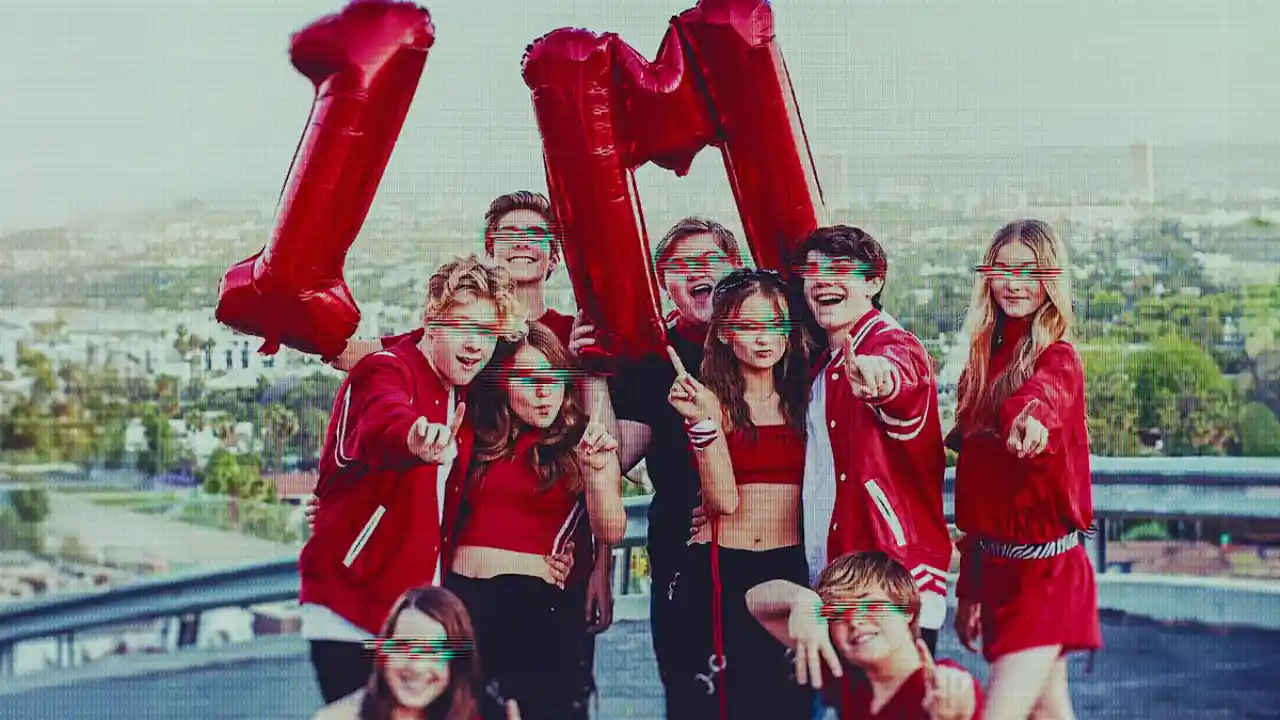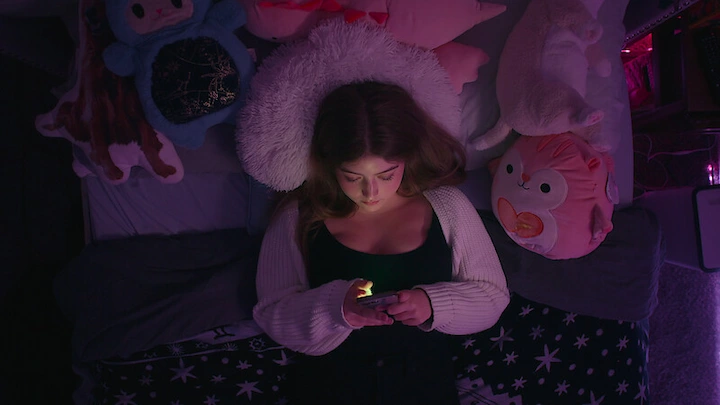Bad Influence: The Dark Side of Kidfluencing Release Date, Storyline, and Everything You Need To Know
For those who followed YouTuber Piper Rockelle and her friends growing up on social media, their world felt playfully idyllic. Known as The Squad, the group carried out elaborate pranks, dealt with crushes, and gallivanted all over Los Angeles in search of a good time, accumulating billions of views — and millions of dollars — in the process.
The new three-part investigative docu-series, Bad Influence: The Dark Side of Kidfluencing, directed by Jenna Rosher and Kief Davidson and produced by Decoy Productions, will premiere on Netflix on April 9. The series lifts the curtain on momager Tiffany and momager Tiffany’s disturbing stories of alleged exploitation, cult-like manipulation, and abuse, told by Piper’s former squad mates.
Bad Influence: The Dark Side of Kidfluencing Release Date
Premise: Bad Influence: The Dark Side of Kidfluencing will hit Netflix on April 9, 2025. Critics and child welfare advocates received a preview screening of selected footage at its announcement this January at the Sundance Film Festival in Snowy Park City, Utah.
Afterward, Netflix picked up its distribution rights and rushed-release. Filmed over five years, directors Jenna Rosher and Kief Davidson finished the final edits in February 2025, shortly before Netflix confirmed the official release date.
The streaming service has scheduled an extensive marketing push before the premiere, including trailer drops on various social media platforms and panels with the filmmakers. The timing of the April release date is particularly calculated to position the documentary for consideration for the 2026 Emmy Awards documentary category.
Description & Storyline Of Bad Influence: The Dark Side of Kidfluencing
The documentary chronicles the evolution of Piper Rockelle’s YouTube channel, which started as innocently enjoyable fare and escalated into an exploitative business, according to several former associates.
Starting with Piper’s early years around 2017, the story follows the journey of Piper’s mother, Tiffany Smith, as she grew the operation by developing “The Squad,” a group of young content creators who would appear together in videos.
The documentary claims that as popularity and profits boomed, behind-the-scenes conditions worsened. Former members said the children were overworked and lacked sufficient breaks and education.
They say they were told to make ever more provocative content to attract views. The documentary shows text messages, contracts, and other evidence supporting allegations that Smith tightly controlled the children using manipulation and intimidation. The plot centers around several members of the Squad who later distanced themselves from the group, usually after their parents expressed concern over the work environment.
That came to a head in January 2022, when eleven former members filed suit against Smith, saying they experienced an “emotionally, physically and sometimes sexually abusive environment.” The documentary scrutinizes the fallout from these allegations and the more significant implications for the mostly free-wheeling world of child influencers.
A Hidden Reality: The Life Behind the Camera
The cheery smiles and rollicking antics of child influencers mask a troubling reality. Young content creators often work long hours and don’t take proper breaks. They have to skip school to shoot videos. Their love lives are fair game; they’re public property.
Parents balance their jobs under little supervision. “These kids are working in an unregulated industry,” says child welfare expert Dr. Samantha Chen. “There are laws that protect traditional child actors. Child influencers have very little of that.”
The documentary features former Squad members discussing 12-hour filming days. One child recalls being told to “act sadder” in a prank video when they weren’t emotional enough. Another says they feel pressured to create more upsetting content to keep the views up.
“In this world, views equal money,” explains a digital media researcher named Jordan Torres. “The algorithm rewards outrage and clickbait. The kids soon discover that bigger reactions lead to bigger paychecks.”
The film shows messages in which Smith urged girls to film when sick or tired. Former Squad member Sophie Fergi has spoken about crying before filming sessions but is told the “show must go on”.
The documentary includes interviews of parents saying they regret their decisions. “I thought this would be a fun hobby that could lead to opportunities,” says one mother. “I didn’t know that I was signing my kid up for a full-time job without benefits, without protections.”
How to Watch Bad Influence: The Dark Side of Kidfluencing
Bad Influence: The Dark Side of Kidfluencing is set to debut exclusively on Netflix on April 9, 2025. The documentary series’ three episodes will be released all at once, a binge-able package that allows the audience to inhale the whole investigation in a single sitting. You can watch the documentary on any device that can get the Netflix app or go to the Netflix website, including smart TVs, phones, tablets, and computers.
Subscribers to Netflix’s standard or premium plans can download episodes for offline viewing when traveling. The series will be released in other languages with subtitles for international viewers.
Netflix also stated that the documentary wouldn’t ever leave the platform, which is home to a growing catalogue of investigative titles. If you don’t have a subscription to Netflix, the site provides a free trial period for new users, a solid opportunity to watch this limited series.
How Children Can Become Parents Power Source
The money side of kidfluencing sets up complicated problems. Young creators earn millions before they’re old enough to have a bank account. Who controls this money? How much do parents take as management? The documentary investigates these troubling questions.
California’s Coogan Law, for example, mandates that 15 percent of a child actor’s earnings be placed in a trust until the child reaches adulthood. This law does not explicitly apply to influencers. The film explains how this legal gap exposes child creators to financial exploitation.
Some of these kids make money that can support their whole family,” says entertainment lawyer David Chen. “When parents rely on their child’s income, it creates an unhealthy power dynamic,” she said.
The former Squad members allege that Smith oversaw all parts of their income. Segments of her contracts, included in the documentary, gave her company a large percentage of each child’s revenue. Some families say they were never adequately compensated for their children’s labor.
The movie highlights the lucrative but shady world of brand deals and sponsorships. Children as young as eight were supposed to negotiate business terms. They advertised products without grasping the commercial nature of their writing. Many said they felt pressured to accept sponsorships they disliked.
“I had to pretend to love toys I didn’t even want to play with,” says one former kidfluencer. “I knew that if I didn’t act excited enough, my mom would be upset because we were broke.” The documentary raises the question of whether parents should profit from their children’s online presence. It explains the legal push for “kidfluencer laws” protecting children’s earnings and limiting their hours.
Interpersonal Relationships and Fan Engagement
It examines the bizarre relationship between young influencers and their fans. Children bear the weight of the happiness of millions of viewers. Fans form unhealthy attachments to creators they’ve never met, which is a perilous situation that interferes with children’s development.
“These parasocial relationships can be have immense pressure on young creators,” says social media researcher Dr. Lisa Wang. “Children take accountability for their audience members’ feelings. They worry about letting down fans who think of them as friends, rather than entertainers.”
Former squad members tell me that a fan favourite can receive thousands of messages daily. Many wrote about intimate problems and sought comfort or advice from kids older than them. Some made lewd comments or sent requests.
There is disturbing footage from meet-and-greet events, where young and incoming fans cried and quaked at being in the presence of Squad members. The film also features interviews with parents concerned about their children’s influence by influencers.
The documentary is peppered with safety concerns. Stalkers threatened dozens of Squad members. Fans came outside their homes—the leaks of personal information online. The film suggests that parents have let these dangers slip past children without protection.
These kids had public filming schedules and locations,” says online safety expert Marcos Jimenez. “Anyone could find them. The parents “valued content creation over basic security considerations.”
The documentary explores the ways young creators find it difficult to have normal relationships. They wonder whether people like them for themselves or for their notoriety. They recount losing friends who were unable to cope with the attention or who felt exploited for content.
Legal Gaps and Calls for Reform
The documentary calls for legal reform to better protect young content creators, pointing out how current child labor laws are ill-equipped to support their needs. While child actors are subject to regulations, a 10-year-old YouTuber can work unlimited hours without oversight, notes children’s rights attorney Julia Martinez.
The film chronicles legislative efforts in several states, including testimony from former child influencers and conversations around proposed bills expanding protections to social media work.
Experts are divided over whether current entertainment laws should be broadened or new rules, tailored to social media, should be enacted. Dr. William Hayes, a media ethics professor, expresses concern that laws must protect people and balance that protection against parental rights, requiring nuanced laws.
The documentary also challenges the role of platforms such as YouTube, TikTok, and Instagram, saying they should offer age verification and enforce guidelines more strictly. However, Teresa Morgan, a digital rights advocate, says there’s a moral imperative for these platforms to protect young creators from exploitation.
Frequently Asked Questions
What is an influencer?
A social media influencer is a child who creates content on social media platforms and is followed by a large number of people. These young creators typically produce videos, photos, or other content that draws the eye and earns money through advertisements, sponsorships, and merchandise.
How much can child influencers make?
Child influencers can earn hundreds of thousands, if not millions, of dollars a year. High-profile kinfluencers like Ryan Kaji of Ryan’s World earned an estimated $25 million annually. Earnings depend on followers, engagement, sponsored posts, and merchandise sales
Do laws protecting child influencers even exist?
Currently, most places have very few specific laws protecting child influencers. Child labor laws weren’t drafted with social media in mind, and the rules don’t always precisely apply to content creation. Some states, including California and Illinois, recently passed or proposed regulations to protect children on social media, but there is little nationwide protection.
How can social media safely involve children in content?
Good parents need to find time and limits for when to film, put their child’s education ahead of creating content, respect the child’s privacy by never posting sensitive moments, put money they make into a trust for the child’s future, and routinely check in about whether that child wants to keep filming. Most salient is that they put the child above politics or a paycheck.
What are the long-term effects of kidfluencing on children?
Research is still emerging, but experts are concerned about the effects on identity development, mental health issues stemming from public scrutiny, stunted social skills from unusual experiences of childhood, and an adjustment period after being thrust into the limelight. Many former child stars say they deal with such issues as adults do.
Final Words
The Issue With Kidfluencers: “Bad Influence” asks the question—and it’s one that’s increasingly urgent as the movie preps to stream globally. The documentary shines a light on the ongoing exploitation of young creators and the fact that many children face the same problems without the public circus surrounding them.
Director Jenna Rosher notes that the film leaves viewers with an active call to action. It urges people to support legislation that protects young creators and pressures platforms to improve their website safeguards. Digital ethics researcher Dr. Aisha Johnson argues that people should use their clicks mindfully because every interaction with exploitative content feeds a toxic machine.
At a time when children are appearing more frequently in reality shows, “Bad Influence” urges society to take stock, balancing the entertainment benefits against the dangers these shows pose to the well-being of children. (Paint, Roque, and Ayo’s former Squad members hope the documentary will help protect other young creators and have started a support network for those affected by early fame.) One interviewee wishes a film like this existed before they began making content; perhaps it would’ve changed what their parents thought of the industry.
Table of Contents



